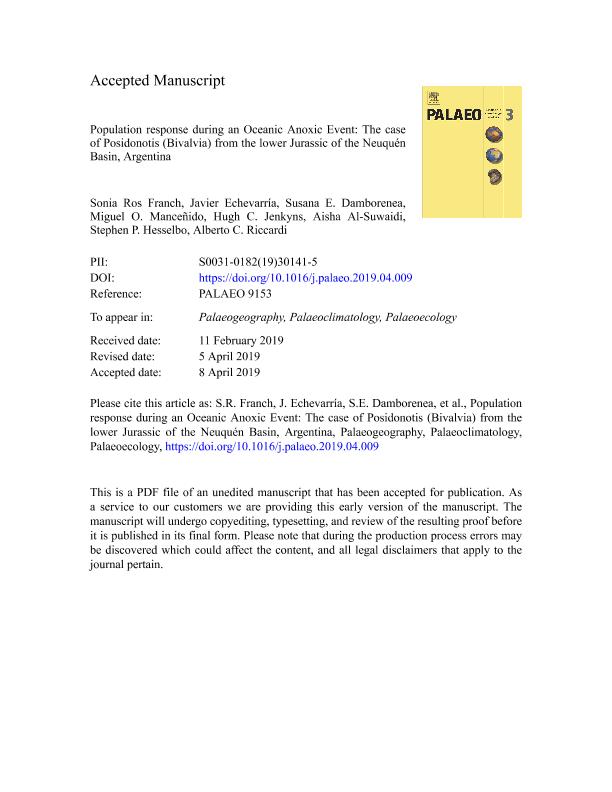Artículo
Population response during an Oceanic Anoxic Event: The case of Posidonotis (Bivalvia) from the Lower Jurassic of the Neuquén Basin, Argentina
Ros Franch, Sonia ; Echevarría, Javier
; Echevarría, Javier ; Damborenea, Susana Ester
; Damborenea, Susana Ester ; Manceñido, Miguel Oscar
; Manceñido, Miguel Oscar ; Jenkyns, Hugh C.; Al Suwaidi, Aisha; Hesselbo, Stephen P.; Riccardi, Alberto Carlos
; Jenkyns, Hugh C.; Al Suwaidi, Aisha; Hesselbo, Stephen P.; Riccardi, Alberto Carlos
 ; Echevarría, Javier
; Echevarría, Javier ; Damborenea, Susana Ester
; Damborenea, Susana Ester ; Manceñido, Miguel Oscar
; Manceñido, Miguel Oscar ; Jenkyns, Hugh C.; Al Suwaidi, Aisha; Hesselbo, Stephen P.; Riccardi, Alberto Carlos
; Jenkyns, Hugh C.; Al Suwaidi, Aisha; Hesselbo, Stephen P.; Riccardi, Alberto Carlos
Fecha de publicación:
01/07/2019
Editorial:
Elsevier Science
Revista:
Palaeogeography, Palaeoclimatology, Palaeoecology
ISSN:
0031-0182
Idioma:
Inglés
Tipo de recurso:
Artículo publicado
Clasificación temática:
Resumen
Benthonic marine species show a wide range of biological reactions to seawater chemical changes through time, from subtle adjustments to extinction. The Early Toarcian Oceanic Anoxic Event (T-OAE) was recently recognized in the Neuquén Basin, Argentina, confirming its global scope. The event was identified chemostratigraphically on the basis of a relative increase in marine organic carbon and a characteristic negative carbon-isotope excursion (δ13Corg) in bulk rock and fossil wood in the upper Pliensbachian–lower Toarcian interval in the Arroyo Lapa section (Neuquén). Simultaneously with collection of lithological samples, a high-resolution biostratigraphical survey was carried out, and the scarce benthonic fauna was collected in order to check the biotic response to changing marine geochemical conditions. We present here an analysis of size and abundance data from the T-OAE interval in the Neuquén Basin for the dominant bivalve species, the paper-clam Posidonotis cancellata (Leanza), and relate these data to geochemical proxies (%TOC and δ13Corg) obtained at the same locality. The abundance of P. cancellata increased when the rest of the benthos diminished, reaching a maximum at the onset level of the T-OAE, and then decreasing. Size-frequency distributions show a noteworthy lack of juvenile shells. Shell size shows a positive correlation with %TOC in the whole section, though over the T-OAE interval proper, it decreases below the level where the maximum %TOC value is attained and increases above it. Posidonotis cancellata shows features of opportunistic species, such as high tolerance to hypoxia, strong dominance in impoverished environments and a strong dependence on primary productivity, but at the same time had a reproductive strategy more similar to equilibrium species, with relatively low juvenile mortality rates. Several anatomical features suggest adaptation to permanently dysaerobic environments. The species disappeared just before the minimum negative carbon-isotope value was reached; and by the same time the genus became extinct worldwide.
Archivos asociados
Licencia
Identificadores
Colecciones
Articulos(CCT - LA PLATA)
Articulos de CTRO.CIENTIFICO TECNOL.CONICET - LA PLATA
Articulos de CTRO.CIENTIFICO TECNOL.CONICET - LA PLATA
Citación
Ros Franch, Sonia; Echevarría, Javier; Damborenea, Susana Ester; Manceñido, Miguel Oscar; Jenkyns, Hugh C.; et al.; Population response during an Oceanic Anoxic Event: The case of Posidonotis (Bivalvia) from the Lower Jurassic of the Neuquén Basin, Argentina; Elsevier Science; Palaeogeography, Palaeoclimatology, Palaeoecology; 525; 1-7-2019; 57-67
Compartir
Altmétricas



